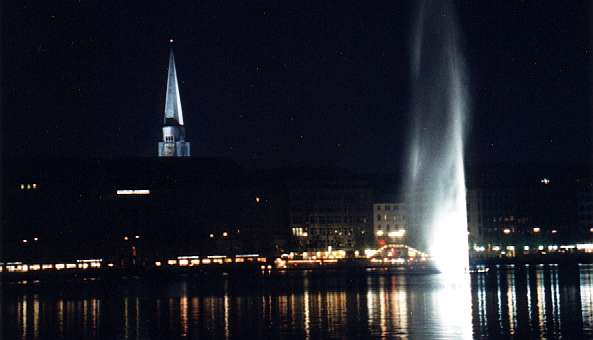

Telemanagement Forum has two annual meetings in various locations around the world. This time it was in Hamburg. Naturally I volunteered to attend. I had seen Hamburg only once before, during my bicycle tour from Copenhagen to Munich, and it was a pretty stressful day. So I was looking forward to seeing more of the city, in a more relaxed way.
The conference hotel was the Radisson SAS, doubtless a business hotel, doubtless a fine hotel, doubtless interchangeable with any other fine business hotel anywhere in the world. What I would really like is to find a B&B, but I don’t think they’re likely in central Hamburg, and I don’t know how to find them anyway. Maybe I’ll settle for a smaller hotel, one where there’s a chance they’ll get to know me after a couple of days. If nothing else, it will at least be different. So I got on the internet, pulled up the city maps, searched for hotels near the conference center, and booked a room at the Baseler Hof, about three blocks away from the conference center. They confirmed with a fax, thanking me for the confidence I had shown in them. Confidence! Oop! Is it that bad? Decided it was just their way of expressing themselves, and confirmed the room.
The conference is Tuesday through Thursday. That means I can’t go in to work Monday or Friday anyway... why not fly over on Saturday and fly back on Sunday, and get in a little sight-seeing? Got my plane tickets (on the internet, of course) just ahead of the 21-day limit, at a good price, likely because I’m staying over Saturday night.
I asked Friedrich for recommendations; he checked with a colleague who knew Hamburg, and emailed a list of things worth seeing.
I had time before my flight; stopped at the Red Carpet club, where I read the German newspapers. Kosovo dominated the stories, but I preferred the one about the ducks of Bath:
|
Stolz sitzt Ente Beatrice auf ihren Eiern und brütet geduldig ihre Zöglinge aus. Voller Nervosität warten ein Bautrupp auf das Schlüpfen der Kleinen. Denn Beatrice legt durch ihre Nestwahl eine 45 Millionen Mark teure Baustelle lahm. Bauarbeiter sollen das 2000 Jahre alte römische Bad im englischen Bath restaurieren. Aber Beatrice hat ihr Nest mitten in der Baustelle aufgeschlagen. Nach dem britischen Naturschutzgesetz darf das Nest eines Tiers nur mit spezieller Genehmigung beseitigt werden. |
Beatrice the duck sits proudly on her eggs, patiently waiting for her ducklings to hatch. But a construction crew is not at all patient as it awaits the great event. Beatrice has paralyzed a 45-million mark project. The 2000-year old Roman baths were to be restored here in the town of Bath, but Beatrice built her nest in the middle of the construction site. Under English law, an animal’s nest cannot be destroyed without special authorization. |
We were late getting started from San Francisco. The pilot apologized; said the aircraft had come in from München, and the passengers had clogged some of the toilets with unauthorized material (he spared us the details). The ground crew had been trying to get them cleared up, but had not succeeded completely. In the interest of schedule, we departed with one or two washrooms unusable.
I sat next to a high-school girl. She was on her way home to Nürnberg after a visit to her extended family in Sunnyvale. Didn’t want to speak German with me.
Not much sleep on the plane.
Immigration at Frankfurt was trivial: the inspector saw I had a US passport and waved me through. With the fast clearance, I almost made an earlier connection to Hamburg, but not quite.
It’s three and a half hours until the flight I’m booked on, and there’s nothing earlier. Well, it’s a chance to lie down and get a little sleep. Frankfurt airport permits smoking only in designated areas, but the rule is honoured only in the breach. Likely it’s a new rule – the bench where I napped was in a designated special area for non-smokers!
Got a window seat to Hamburg. Very nice: green and pretty, reminds me of the Netherlands – water everywhere, canals, rivers, streams, ponds and lakes. Wind turbines.
I wanted the bus to Ohlsdorf U-Bahn, but the only bill I had was a hundred, and the bus driver wouldn’t change it. Went to the Geldautomat, got 200 marks more, including a pair of 50s. Is that still too big to change? Got on the bus – there was no charge! Then I discovered I had boarded the parking shuttle. Free tour of all the parking lots. Boy, am I spacey after that long flight.
When eventually I got back to the terminal, the first available bus went to the Hauptbahnhof. Even better – I can walk to the hotel from there. The driver turned away someone ahead of me with a hundred, but changed my fifty without a squawk.
Pretty drive into town. From the bus I saw Chinese, Thai, Indian restaurants. Nice to know I won’t starve. Got off at the station, and naturally went the wrong direction. Since I wanted to go the water, I headed downhill, came out on the Außenalster. The Binnenalster (inner Alster lake) has a vertical jet of water from its middle, really wonderful in the late sunlight.
I had it in mind that I wanted Jungfernstieg, so that’s where I went. Just across from the Binnenalster, reminds me of the expensive section of Toronto’s Bloor street. No hotel.
At the end of Jungfernstieg is a Platz, Gänsemarkt. The only geese I saw were those in the crowd around some rabble-rouser with a megaphone. I couldn’t understand much, just words such as amerikanischer Imperialismus. He was working the crowd up to a chant, “NA-TO raus!” Lots of police cars around the corner on the side street. Four soldiers standing around looking disgusted. Can’t blame them. Even if I happen to agree with someone’s position, I’m always strongly opposed to demagogues.
The International Herald-Tribune had a cartoon of Clinton and NATO, each chained, hand and foot, to a dungeon wall. NATO looks pretty discouraged, but the bright-eyed Clinton is saying, “Ok, now, here’s my plan!”
No hotel anywhere to be seen. Unloaded my backpack, dug through my stuff, found the address, looked it up on the map: Esplanade. Ok, a couple of blocks away. Also a busy street, but quieter than the protest rally. A high-rise monolith across the park with the sign Radisson SAS.
At the Baseler Hof hotel, I said, »Ich heiße Hood,« and the clerk said, “We were expecting you!” I didn’t even have to check in – they handed me a key and that was it. I’ll bet Radisson wouldn’t do that! A pleasant place, nice people. There’s a marble-clad staircase with steps thoughtfully arranged so I can take them two at a time to my room on the third floor. I’ll bet Radisson doesn’t have that! The room is microscopic, bare white, opens onto a courtyard away from the busy street. Just fine with me – it’s clean, quiet, inexpensive and a good location.
They welcomed me to Hamburg with a three-day transit pass. Since it’s stamped with today’s date, it only gets me two more days of transit. Kein Problem – after tomorrow, I’ll be in the conference anyway.
The hotel restaurant is the Klein Huis. I think I’m in Plattdeutsch country. Dropped my stuff, went out in the twilight to wander. Not really hungry, but I don’t want to just collapse into bed. Just around the corner is (are?) the Colonnaden, with pleasant little shops. I may have found myself in the book district – there are at least three bookstores, including an antiquarian used-book store. And then there’s Große (and Kleine) Operstraße. The Staatsoper is doing Verdi’s Traviata Tuesday night. Will I be awake by then? Gustav Mahler, it turns out, was conductor of the Staatsoper for a time.
And just a bit further down, Yang’s Szechuan restaurant. They had Erdinger dunkles Weißbier, served of course with a thick head of foam in a glass labelled Erdinger Weißbier. Nice to be back in Germany. I’m pretty spoiled.
Woke at 5:15; no going back to sleep. Fortunately the hotel is civilized; it offers breakfast from 6:15. I got there at 6:30, and they were still setting things out. Pretty good – the kind of breakfast you get used to in European hotels, a breakfast that spoils you for anything else. A buffet with Müsli, dark seedy rolls, fresh fruit either in juice or salad. For those into salt, fat and protein, there was ham, cheese and various forms of eggs. And there was a separate room for the smokers.
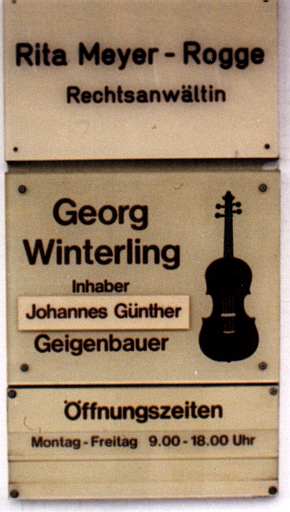
The first thing I noticed as I left the hotel was a violin-maker’s sign. Discovered later that the Stephansplatz U-Bahn station has, amongst its advertising displays, one from an antiquarian bookseller, another from a store that sells classical sheet music. Is this a classy neighborhood, or what!
Cold and gray today. This weather is better suited for tomorrow, when I’ll be in conference. Oh, well. Friedrich’s colleague had recommended Övelgönne, which was not on my map. The hotel’s bumpf recommended a boat trip to Finkenwerder, on to Teufelsbrück and back by bus. Since my transit pass is also good on the ferries, these are things I should do today. The hotel clerk said I should catch a 112 bus to Neumühlen, where Övelgönne is.
Although I like public transit, I’m not much of a bus rider. Maybe I’ll save that for later. Wandered down toward the Landungsbrücken, where the ferries are.
Lo and behold - the ferry to Finkenwerder makes a stop at Neumühlen. And there’s a boat every fifteen minutes, so I’m not stuck longer than I want to be.
The south side of the Elbe is very industrial, a forest of cranes as far as the eye can see. Further from the Centrum, opposite Neumühlen, is a busy container port, and toward Finkenwerder is a tank farm. Hamburg has to be one of the biggest ports in Europe.
I guess industry built itself up on a whole cluster of islands and landfill that populate the estuary. Don’t know whether the Elbe still floods, but the street names are suggestive: Deich-, Damm-, Wall-. There’s even a Bollwerk. In the industrial area we see the evolution of the language in successive streets: Kei, Kai, Quai. There is also a Brook and a Fleet, but if they mean the same thing they would in English, there has been a lot of sedimentation, fill-in and land creation since those streets were named.
Neumühlen itself is a quiet little landing. The museum harbor is disappointing, six or eight boats, the largest an Eisbrecher aus Lübeck. Normally they’re open as floating museums, but not today.
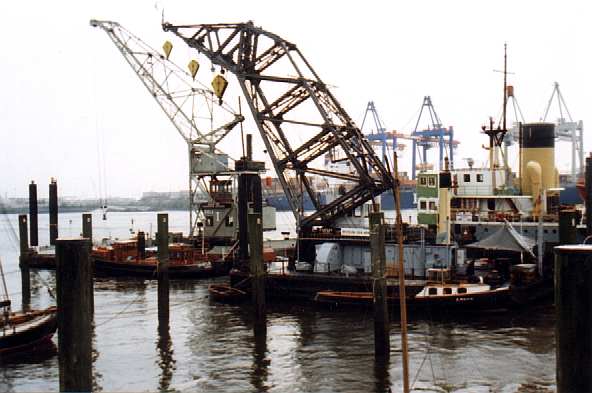
I especially liked the surfboard these people take along, just in case the opportunity should present itself.

Wandered along the walk above the beach. Some very pleasant homes here overlooking the water. Found a manhole cover for Allison’s collection.

A woman was out dismantling her Easter tree. Some very nicely decorated eggs.
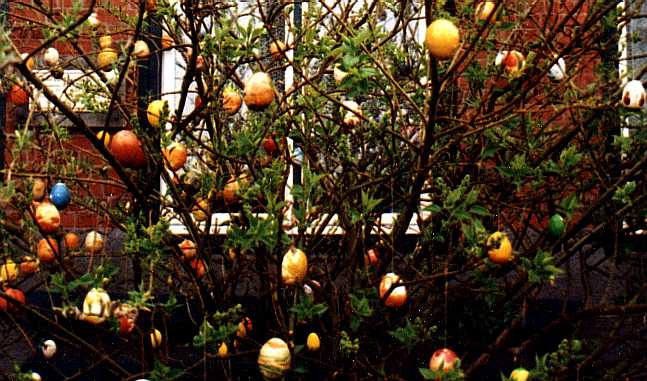
I climbed the hill to the town above. Nice enough, nothing special. Back down to the ferry, on to Finkenwerder. The map at the landing showed an Altstadt, so I wandered that way. Most interesting places were a couple of half-timbered buildings with thatched roofs. Otherwise, another pleasant place, but nothing special. Have to admit the rain dampened my enthusiasm.
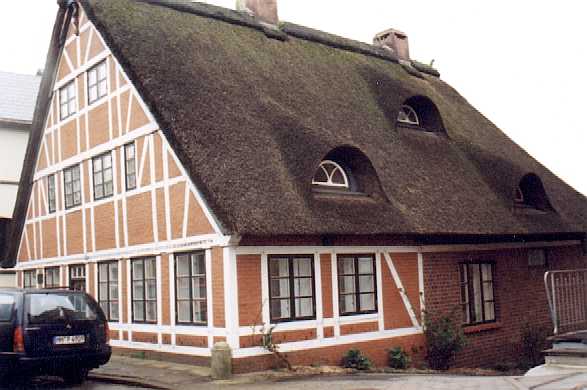
Wandered along the flood wall for a ways, but there’s not much to see. I didn’t understand Spülfeld – is there some industrial installation nearby that can release massive flows of water without warning? – but I understand Lebensgefahr. Didn’t explore in here.
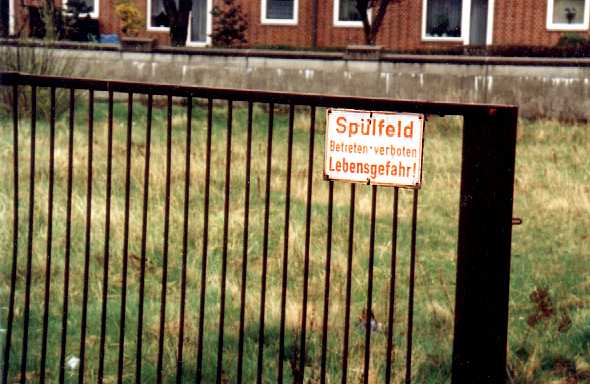
Friedrich later told me these are areas that were formerly subject to industrial runoff, and are contaminated with toxic waste. The ground can also be undermined, and cave in without warning.
I liked the picture as much as the text on this car’s windscreen.
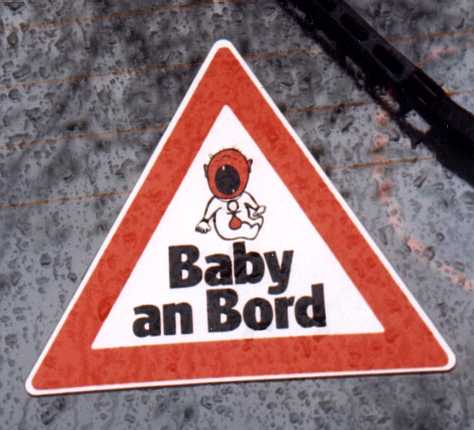
On to Teufelbrück? Or just back to Hamburg? Enough of this rural stuff. It would be nicer on a bright, sunny day. Hamburg it is.
Just across from Finkenwerder (one sign also says Finkenwärder, the name of an original family) is – what? – an old lighthouse? and a sign that guides tankers down this particular reach.

I got the following update after posting this web page:
|
I thought I would let you know that the “old lighthouse” opposite Finkenwerder is actually the pilot station for the harbour pilots. River pilots are relieved between Teufelbrück and Finkenwerder and the Harbour or Docking Pilots (the more skilled ones if you ask them) take over until the vessels are docked. Towards the left (north) you would have come by (possibly stopped at) a landing pontoons for the ferry and the pilot boats. Above the clock in the tower you see three rectangular windows, which indicate the level of the tide to the passing traffic. And on top of the building you see a radar antenna for the traffic advisory system. The European harbour pilots operate very good radar based guidance systems on their rivers and in ports to assist vessel transit in any weather condition (very much like air traffic controllers, only staffed by the river and harbour pilots themselves). The dispatchers are located in the round pavilion towards the left and have (weather permitting) visual contact to in- and outbound traffic. The sign to the left (as you say) indicates the tanker berth (actually one of many in the port). Sincerely, Capt. Jes U. Andresen |
Thanks to Capt Andresen for other corrections scattered throughout.
The Blohm & Voss drydocks are high, featureless black walls with cranes overhead. They have been pumped dry and are now floating. There are several right across from Hamburg city.
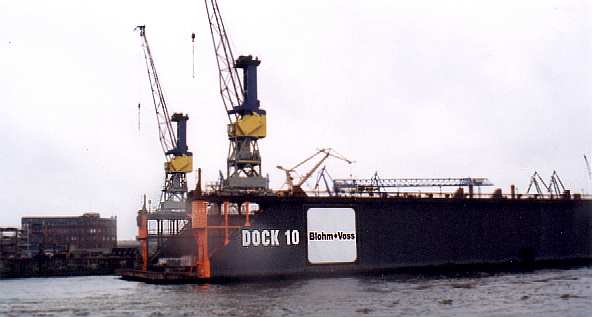
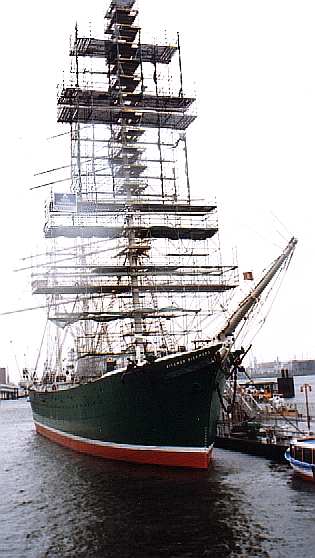
We observed some years ago that every real building in the world is at least partially covered with scaffolding. But ships, too!? This is the Rickmer Rickmers, a museum ship. |

A crew was busy putting up a street sign. I liked their somewhat informal approach. |
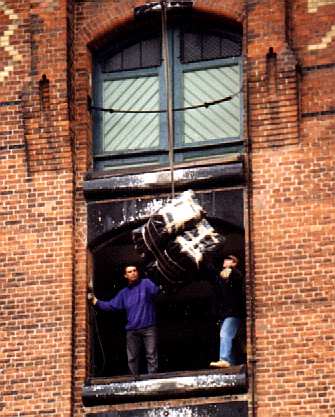
Back in Hamburg, I wandered along the shore to Speicherstadt, a warehouse district built around a tree of canals. The warehouses are still in use today, though the loading is from trucks on the landside, rather than from ships. From the signs, much of the trade would seem to be in oriental carpets. |
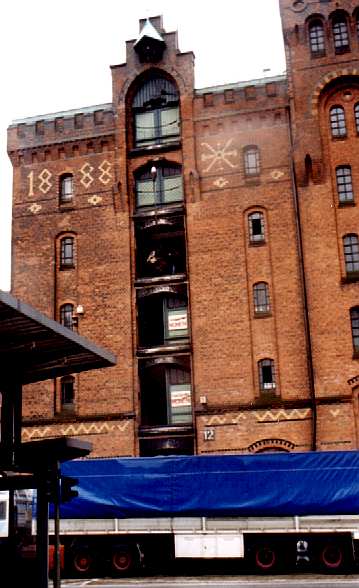
Much of the area is a free port, quarantined with chain-link and barbed wire from the rest of the city. No hassles for pedestrians or private cars to come and go at will, but I imagine a truck driver would have to show some paperwork to go through here. |
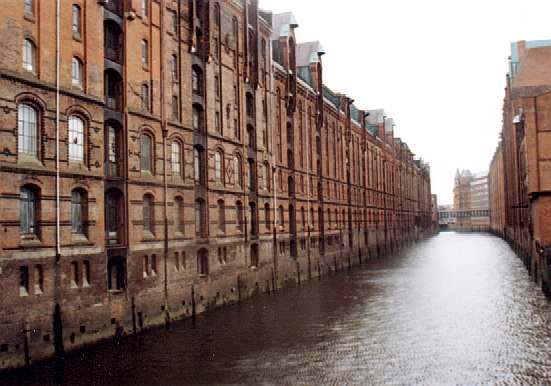
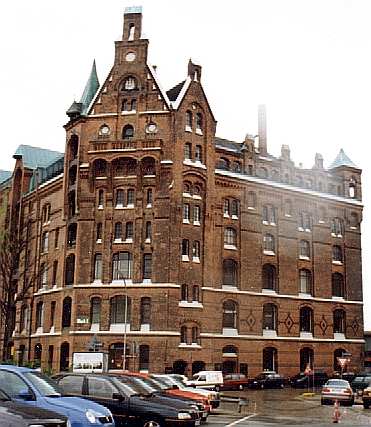
At one display on the history of the area, it says the warehouses were regarded as purely functional when they were built around the turn of the century. Their faithful restoration after the second world war is due to the efforts of those who appreciated their tradition and aesthetic appeal. The buildings are being re-invented: one of them houses CyberRadio.de. |
Crossed back into the city. Saw an ICE-train just outside the Bahnhof. Hamburg is a media center, too: Die Welt is here, and a building is marked Der Spiegel TV.
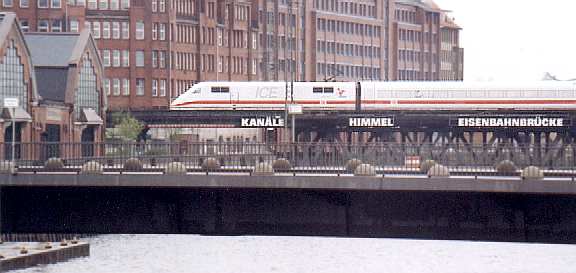
History, too. The first building I came to was interesting...
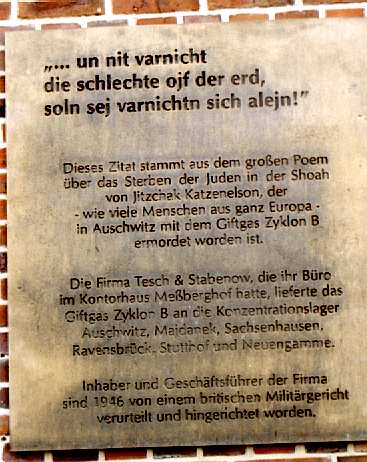
|
"...and do not destroy This citation is taken from the great poem about the death of the Jews in Shoah, by Jitzchak Katzenelson, who, like many from all across Europe, was murdered by the poison gas Zyklon B in Auschwitz. The company Tesch & Stabernow, whose offices were in this building, delivered Zyklon B to the concentration camps Auschwitz, Maidanek, Sachsenhausen, Ravensbrück, Stutthof and Neuengamme. In 1946, the owner and manager of the company were sentenced by a British military court and executed. |
Then I wandered through the shopping area. Stopped in a big bookstore. I think this is the first time I’ve been in a German bookstore with the intent to buy something, but we’ve been talking about reading Den Vorleser in German class, and I may as well buy it and read it on the plane.
I didn’t see it on the best-seller tables, and I didn’t remember who the author was. But there were computer kiosks here and there. Wandered up to one, selected the title menu, started to type Vor- when I was interrupted by a clerk who told me it was »keine Selbstbedienung«. Ok, fine, then help me yourself – no, her job description was only to shoo people away, not to actually help them. One of her colleagues would help me. Moomph!
So I wandered over to another kiosk, typed in Vorleser, got the author’s name: Bernhard Schlink. When the dragon accosted me, I at least knew what I wanted, and she found it for me straightaway, on a table of best-sellers! You just have to know where to look.
Not very hungry, but I stopped at a Bäckerei for a Brötchen covered with Kurbiskerne – another of the great little things that spoil you in Germany.
Nice to duck into the arcades and covered malls, since it’s still rainy. One of the flyers says Hamburg has more covered arcades than any other city in Europe. I presume this is a tacit admission that it rains all the time. They also say Hamburg has more bridges than Amsterdam and Venice combined!
In one of the arcades, there’s a ring of plaster sculpture between the ground and first floors. My attention was first caught by the octopus, then by the heron, frog and such.
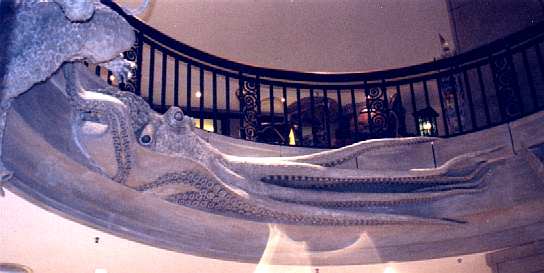
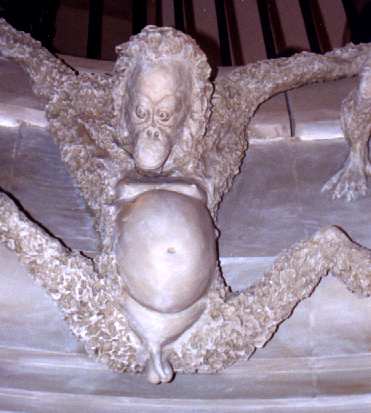
But my favorite was the anatomically-correct chimp. |
The Platz had some rolling mounds here and there, and the kids loved them.
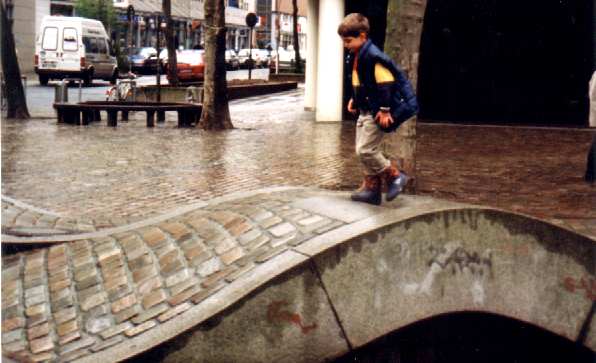

So far I haven’t gone into any churches. That has to be some kind of record. Stuck my head in at St Petri, but protestant regions just don’t produce the level of elaboration you find in Catholic regions such as Bavaria or France. The Rathaus was worth a picture. |
Beyond the Rathaus, under cover of the Alster arcade, were two street musicians. Classical instruments, classical music – worth a donation. Besides, I’m accumulating too many junk coins. How better to get rid of them than to dump them in someone’s donation box?
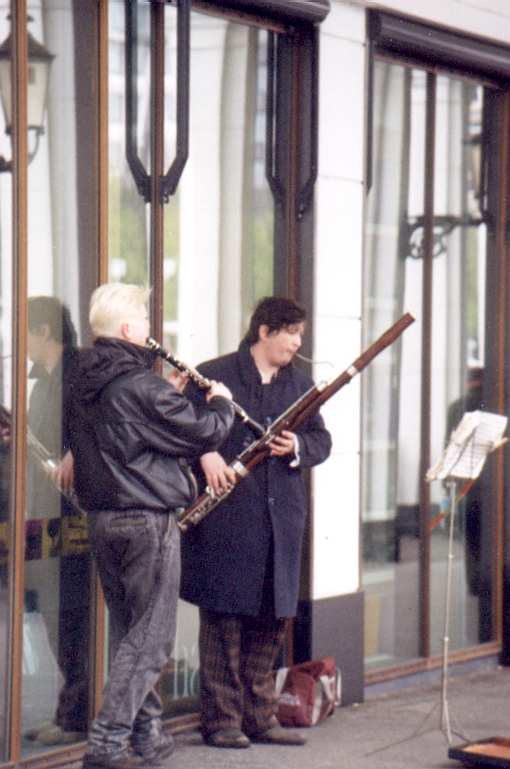
Mid-afternoon, time for a nap at the hotel.
Out again about 4:30. The room had been cleaned up, but there was no bath towel. No sign of maid service in the corridor. Oh, well – I can make do with a hand towel. Moomph!
The Frühjarsdomfest is on, one of three Doms every year. Dom? For an amusement fair? Well, it appears there once was a cathedral here somewhere, used by mendicants as a convenient site for their wares and fares until the bishop kicked them out – this was in the thirteenth century. But the people protested so much that the church had to yield. Today, as far as I know, there is no connection with any church of any kind.
So I went to see the Domfest. It was raining again, slow and steady. Moomph! But the crowds were about the size I like to see: nonexistent. Too bad about the dozens of stands waiting hopefully for customers. Their best customers were the police who had been detailed to the fair, and were there because they had to be.
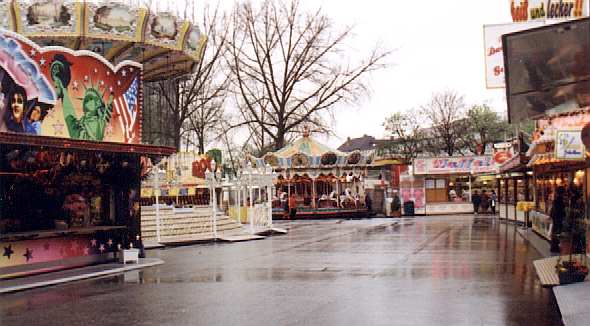
Next venue: the Reeperbahn. One sex shop after another. Boring. Tried a side street to see if there might be an Indian restaurant off out of the way: no. The Reeperbahn was also almost deserted; the rain is one factor, but they say it really doesn’t come to life until after midnight anyway.
Reeperbahn ends at a very obvious, very abrupt transition to Altona, which appears to offer nothing of interest. Turned back toward the hotel – baked potato tonight? – and it stopped raining. Oh, well, why not? Checked the map. It looks as if the real Altona may be beyond a strip of park and apartment buildings.
It turned out to be one of those dreadful cookie-cutter pedestrian malls, completely devoid of charm and interest. The only incentive to continue was the S-Bahn station ...and at the station, I noticed more pedestrian mall on the other side. I decided to give it one more block, just to see if it might be a little more interesting. Basically, no.
Turned onto a side street, meaning to loop back to the S-Bahn, when I saw an Indian tandoori sign just a bit further down Ottenser Hauptstraße. It was a hole in the wall – the best kind – and they had Madras curry. The Franziskaner Weißbier was served, of course, in a glass marked Franziskaner Weißbier.
What I like about Madras curry is that the first bite seems disappointingly mild, but the flavour builds up gradually, so that by the end, you have enjoyed a really scharf dish! Well, this place accelerated the pace a bit. My forehead started sweating just from the aroma as they laid the meal before me. It was almost (but not quite) too scharf, even for me. That’s not pain; it just feels like pain. Pretty, pretty good.
Took the S-Bahn back to Dammtor, about a block from the hotel. Raining again, time to pack it in.
In my room I found a bath towel, and the bed had been straightened up. These people have their act together! Good for them!
Read a couple chapters of dem Vorleser before falling asleep.
Dave Hood home
Email: ![]()